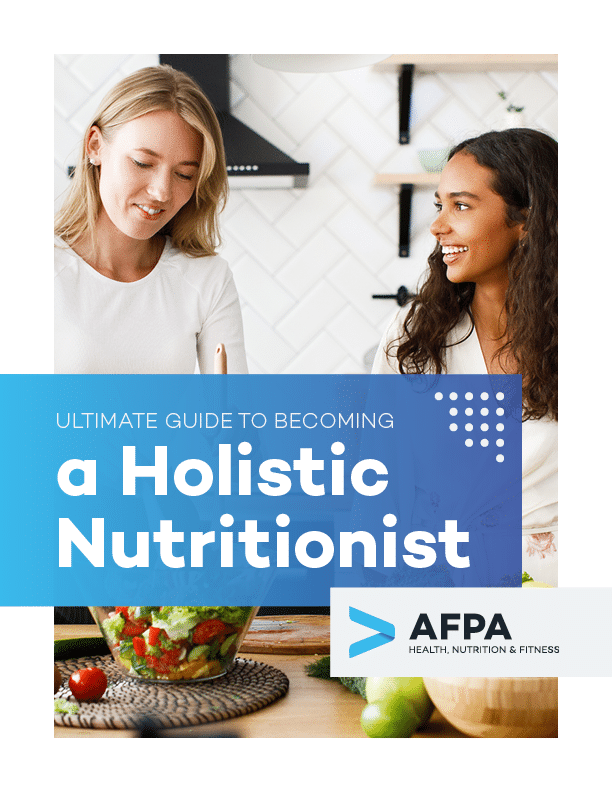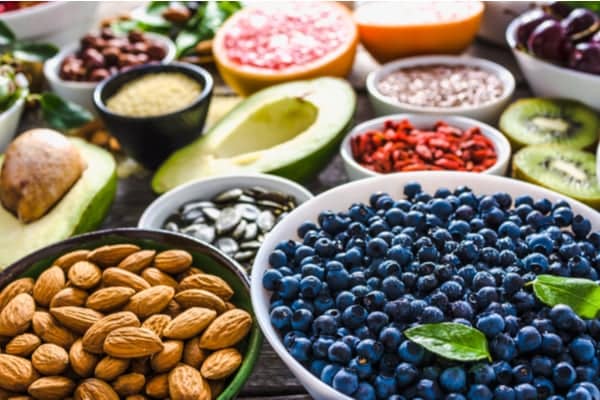As warm weather, summer cookouts, and spontaneous beach trips make way for the cool breeze, amber-red fallen leaves, and the irresistible smell of pumpkin spice lattes … there’s no denying our transition into the most charming season of the year: fall.
And for most (e.g., your client), the mere mention of fall is enough to evoke cravings for warm stews, hearty casseroles, and gulps of soul-warming pumpkin chai latte.
Mac and cheese, apple cider donuts, and pumpkin bread are undoubtedly delicious. But these ultra-processed foods are also calorie-bombs capable of setting back your client’s weight loss progress by weeks.
Luckily for you and your client, there are a lot of better-for-you foods (fruits and vegetables in season this fall) to get excited about. Read on to find out what they are.

Get Your Free Guide to Becoming a Holistic Nutritionist
Learn about the important role of holistic nutritionists, what it takes to be successful as one, and how to build a lucrative, impactful career in nutrition.
Apples
Apples are a staple for the fall season.
From sweet Honeycrisp to tart and tangy Granny Smith, there’s a flavor for every palate—so there’s no need to worry if your client is a picky eater. While apples may not seem like the most exciting or exotic fruits around, you shouldn’t underestimate their nutritional value.
A medium-sized apple (200 grams) provides:
- 104 calories
- 0.5 grams of protein
- 27.6 grams of carbohydrates
- 0.3 grams of fat
Doing the math, an apple only contains (approximately) 50 calories per 100 grams. Compare that to a chocolate candy bar, which contains an eye-watering 567 calories per 100 grams, and you’d see which is the lower calorie-density food option.
In fact, apples are known to have one of the lowest-calorie densities of all foods.
This means apples can help your client keep hunger pains away on fewer calories—and for longer—effectively reducing their total calorie intake per meal. And, thus, potentially boosting their weight loss efforts.
It’s not just all about calories, either. Apples are also a rich source of fiber, vitamins, and minerals essential for optimal health:
- Fiber: A medium-sized apple contains about 4.8 grams of insoluble and soluble fiber, 17% of the Daily Value. Soluble fiber can help lower blood cholesterol and glucose levels, while insoluble fiber promotes bowel health by increasing the weight and size of your stool.
- Quercetin: Apples contain a powerful natural antioxidant known as quercetin. Research shows that this free-radical-fighting compound may have anti-inflammatory, antiviral, anticancer, and antidepressant effects.
- Potassium: Less than 2% of Americans get in the recommended 4,700 mg of potassium per day. That’s where apples could potentially help; each medium-sized crunchy fruit offers 107 mg of potassium, which helps regulate fluids in the body—and improve blood vessel function.
Cranberries
Just like apples, cranberries are low-calorie treats that provide just 50 calories per 100 grams. Better still, these ruby-red, juicy little berries are also incredibly nutritious—and deliver some surprising health benefits:
- Vitamin C: One of the predominant antioxidants in cranberries, vitamin C has been linked to a slew of impressive health benefits, including immune system support, high blood pressure management, and even cardiovascular disease protection.
- B-complex vitamins: Cranberries are a rich source of B-complex vitamins (i.e., all 8 B vitamins)—the building blocks of a healthy body. B vitamins help promote cell health, red blood cells’ growth, energy levels, good eyesight, brain function, and even cardiovascular health (amongst others).
- Flavanols and polyphenols: The ruby-red beauties are also very high in bioactive plant compounds and antioxidants—particularly flavonols and polyphenols. Quercetin is a good example. Another is something called “A-type proanthocyanins,” believed to be effective against UTIs.
Keen to have your client add cranberries to their diet? Be sure that they’re not consuming the berries in the form of a jam, as those are typically not only packed full of added sugars but also stripped of vitamins and minerals.
Instead, have your client eat their cranberries fresh.
Another option to consider—if your client finds fresh cranberries too tart for their liking—is to look for unsweetened, 100% cranberry juice.
Note: It’s also crucial for your client to get the all-clear from their primary healthcare provider before increasing their intake of cranberries.
That’s because cranberry products could lead to increased bleeding in individuals who use warfarin (a blood-thinning drug) and promote the formation of kidney stones in those who’re susceptible to calcium oxalate-type stones.
Pumpkin
Pumpkin pies. Creepy, carved jack-o’-lanterns. It’s a challenge to think of the fall holidays, Halloween and Thanksgiving, without also thinking of pumpkins: a bright orange fruit that’s at the root of fall’s most favorite flavor.
And just so you know, pumpkin is one of the healthiest—and most nutrient-dense—vegetables you can get your client to eat.
As is typical of most fruits and vegetables, pumpkin is low in calorie density (it’s 94% water!), containing just 26 calories per 100 grams. But, of course, thanks to its impressive medley of vitamins and minerals, the squash also packs a bunch of health benefits:
- Vitamin A: Pumpkin is one of the best-known sources of beta carotene, a powerful antioxidant that gives orange vegetables and fruits their vibrant color. The body converts any ingested beta carotene into vitamin A, a nutrient essential to vision, growth, cell division, reproduction, and immunity. One cup of cooked pumpkin (245 grams) provides your client with 245% of the RDI for vitamin A.
- Potassium: The high potassium content in pumpkins can help support heart health. Numerous studies have found that people with higher potassium intakes appear to have lower blood pressure and a reduced risk of strokes: the two primary risk factors for heart disease.
- Fiber: Pumpkin’s high fiber content can help keep your client’s trips to the bathroom regular, manage blood sugar levels, and even promote satiety (i.e., the feeling of fullness)—in turn, supporting your client’s weight loss efforts.
Brussels Sprouts
Brussels sprouts are simply the best during fall.
These “mini-cabbages” are wonderfully versatile, working well with a wide variety of different sauces and seasonings, and a plus point: They’re even delicious simply stir-fried or roasted with a dash of oil—reliably sporting a crispy exterior with an irresistibly soft core.
Other than their versatility and taste factor, brussels sprouts are also nutrient powerhouses.
These sprouts provide an impressive range of vitamins, minerals, and antioxidants linked to several health benefits:
- Vitamin K: Just half a cup of cooked brussels sprouts provides 137% of your client’s daily vitamin K requirement. Vitamin K plays an essential role in coagulation (i.e., the formation of blood clots that stop bleeding) and bone growth. A 2009 review even found that vitamin K could decrease the risk of bone fracture in postmenopausal women.
- ALA omega-3 fatty acids: If your client follows a vegetarian or vegan diet, eating enough omega-3 fatty acids—shown to reduce blood triglycerides, slow cognitive decline, reduce insulin resistance, and decrease inflammation—can be a challenge. Thankfully, brussels sprouts are one of the best plant sources of omega-3 fatty acids around, with 135 mg of ALA in each half-cup serving of cooked sprouts.
- Folate: A half-cup of cooked brussels sprouts provides 12% of the RDI for folate—the natural form of vitamin B9 that your client’s body needs to maintain red and white blood cells, convert carbohydrates into energy, and maintain the body’s genetic building blocks (i.e., DNA and RNA). A daily folate intake is especially crucial for pregnant clients, as the nutrient is needed to ensure a healthy pregnancy.
Takeaways
Encourage your clients to make the most of the incredible nutritional benefits of the fresh harvest available during the fall season. And, of course, an occasional reminder not to overindulge in calorie-dense, fall-inspired foods would certainly help your clients stay on track with their health and fitness goals as well.

Get Your Free Guide to Becoming a Holistic Nutritionist
Learn about the important role of holistic nutritionists, what it takes to be successful as one, and how to build a lucrative, impactful career in nutrition.
References
- https://fdc.nal.usda.gov/fdc-app.html#/food-details/1102644/nutrients
- https://fdc.nal.usda.gov/fdc-app.html#/food-details/1813836/nutrients
- https://pubmed.ncbi.nlm.nih.gov/16002798/
- https://pubmed.ncbi.nlm.nih.gov/26162950/
- https://pubmed.ncbi.nlm.nih.gov/19335713/
- https://www.ncbi.nlm.nih.gov/books/NBK559033/
- https://www.ncbi.nlm.nih.gov/pmc/articles/PMC7254783/
- https://pubmed.ncbi.nlm.nih.gov/23674806/
- https://fdc.nal.usda.gov/fdc-app.html#/food-details/1795808/nutrients
- https://www.webmd.com/food-recipes/health-benefits-cranberries
- https://www.ncbi.nlm.nih.gov/pmc/articles/PMC3783921/
- https://www.ncbi.nlm.nih.gov/pmc/articles/PMC6930747/
- https://www.ncbi.nlm.nih.gov/pmc/articles/PMC7436188/
- https://pubmed.ncbi.nlm.nih.gov/17919554/
- https://pubmed.ncbi.nlm.nih.gov/14616463/
- https://fdc.nal.usda.gov/fdc-app.html#/food-details/168448/nutrients
- https://nutritiondata.self.com/facts/vegetables-and-vegetable-products/2601/2
- https://pubmed.ncbi.nlm.nih.gov/17639513/
- https://nutritiondata.self.com/facts/vegetables-and-vegetable-products/2363/2
- https://pubmed.ncbi.nlm.nih.gov/19410972/
- https://pubmed.ncbi.nlm.nih.gov/22113870/
- https://pubmed.ncbi.nlm.nih.gov/16216930/
- https://pubmed.ncbi.nlm.nih.gov/17497447/
- https://www.nature.com/articles/srep08506



